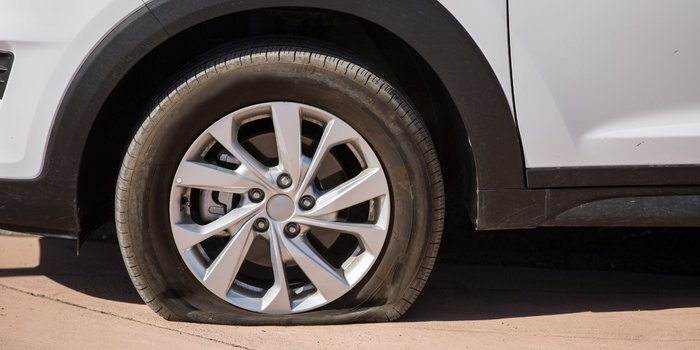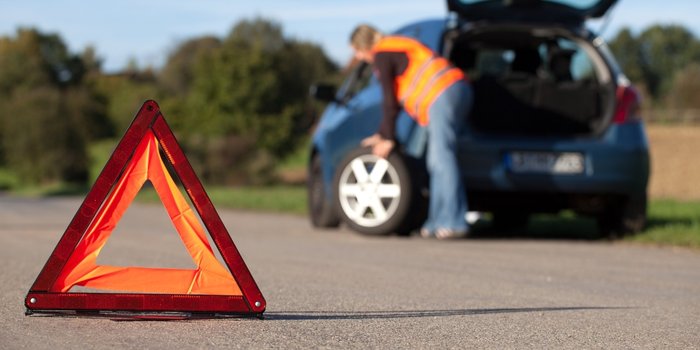Suppose you are on a busy highway or rushing toward an important place. But suddenly your vehicle tire gets punctured while driving. This situation can be panic, dangerous as well as it’s harder for you to control the car.
Drivers may be confused about what to do next. To solve your problem, we have prepared this guide. You will explore if it is possible to drive on a flat tire and how you can handle a flat tire safely.
How Far Can You Drive on a Run Flat Tire?
Normally, you can drive up to 50 miles with a flat tire; however, each manufacturer has different guidelines regarding the maximum distance you can drive with a flat tire. You should read the manual carefully and avoid driving for extended periods.
This range is for reaching the tire shop or any nearby workshop. Exceeding the limit can cause harm to the tire and other parts.

Driving on a Flat Tire Short Distance
Driving on a flat tire is always risky, especially if your tires are not run-flat. However, with a lower speed and having less weight in your vehicle, you can drive a short distance to reach any tire shop or get some help.
Can I Drive a Flat Tire 2 Miles?
It is unsafe to drive with a flat tire for 2 miles; however, if it is the last option, then you can drive under 15mph and drive smoothly to avoid sudden breaks and jumps. Driving with a flat tire can damage the rim, braking system, and shred the tire’s rubber, making it irreparable.
How Long Can a Car Sit on a Flat Tire?
Normally, it is safe for a few hours to leave your car in such a position. However, if your tire is flat and the vehicle remains in a parked position for 1-3 days, the tire will start deteriorating, and its sides will become weak, making its restoration difficult. More than 1 week can cause permanent damage and also harm the suspension.
How Fast Can You Drive on Run Flat Tires?
In case you are using run-flat tires, you can drive them below 50 miles per hour. Driving at a slow speed reduces pressure and heat to the tire. You can reach your destination by moving slowly below this speed. You should also read the manufacturer’s guide because it may vary.
Can You Drive on a Flat Tire in an Emergency?
Yes, in case of an emergency, you can drive on a flat tire; however, the risk factor always remains there. If you are using run-flat tires, you can drive up to 50 miles at a speed below 50mph. Your speed limit is 15mph in case of normal tires. By following these standards, you can drive in an emergency.
What Are the Disadvantages of Run Flat Tires
What about driving on flat tire damage? Many people like you ask how bad it is to drive on a flat tire? Let’s find out below.
-
Vehicle Safety Risk
As these tires are hard compared to the regular tires, they maintain their normal shape even in the case of a puncture, so ultimately, your vehicle is on a safety risk. These tires are stiff, so you will not get a comfortable ride, as regular tires provide.
-
Wheels & Suspension Damage
You will not notice that your tire has less pressure or that it is damaged. It will lead to more pressure on your rim and ultimately on the suspension, and cause costly damage. You must observe your tires physically to avoid such incidents.
-
Chances of Losing Control
Run-flat tires have less traction control compared to regular tires when they are deflated. Your braking and handling control will also be reduced when your tire is punctured.
How Far Can You Drive on a Rim?
Driving on a rim is very dangerous for your car, as the rim will bend and put immense pressure on your suspension and braking system. You can drive a maximum of 1 km in case of extreme emergency.

Can You Put Air in Run-Flat Tires?
Yes, these tires are not made fully of solid rubber. You have to fill air in these tires for normal functioning. Different cars have different air pressure ranges in their tires, depending on the tire and the weight of the car. Proper pressure makes your drive safe and comfortable.
What To Do If You Get a Flat Tire?
If your tire is punctured and it gets flattened, you must follow the instructions below.
Reduce Vehicle Speed
First of all, you should reduce the vehicle speed gradually. Don’t apply sudden brakes, as you may have an accident. A reduced speed will save you from any sudden response.
Move To the RoadSide
Another precautionary measure is to move your car to the roadside to avoid any collision with fast-moving vehicles. You must not move suddenly; however, gradually shift your car to the roadside and observe physically.
Use a Spare Tire (Donut)
The spare tire, also known as a donut, is small in size and usually used for taking the car to a mechanic. You can not drive so long on these tires.
Call Roadside Assistance
If you are on a highway or motorway, you should call the local police/ or any responsible body for help to get out of trouble.
Tire Repair Kits / Inflators
Nowadays, advanced tire repair kits are easily available in the market. You should have such a kit for providing a sudden solution in case of a small puncture and avoiding tire replacement. Inflators can fill the air temporarily to keep the tire safe for a short period.
Run Flat Tire Cost
The cost varies from brand to brand. However, it ranges from $150-$300 for mid-range sedans in the US. The cost is higher for larger vehicles. In UK, the cost is between 100 to 300 pounds. In India, the value is approximately 39000 INR to 45000 INR per tire.
To Conclude
We hope now you have clear information about the risks and challenges of a punctured tire. To keep yourself, your passengers and your vehicle safe, you have to follow the right steps and precautions. So, next time when you face this situation, you will be better prepared to handle it confidently.


-80x69.png)

